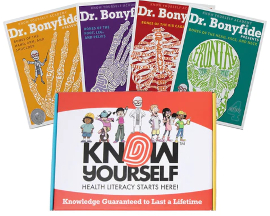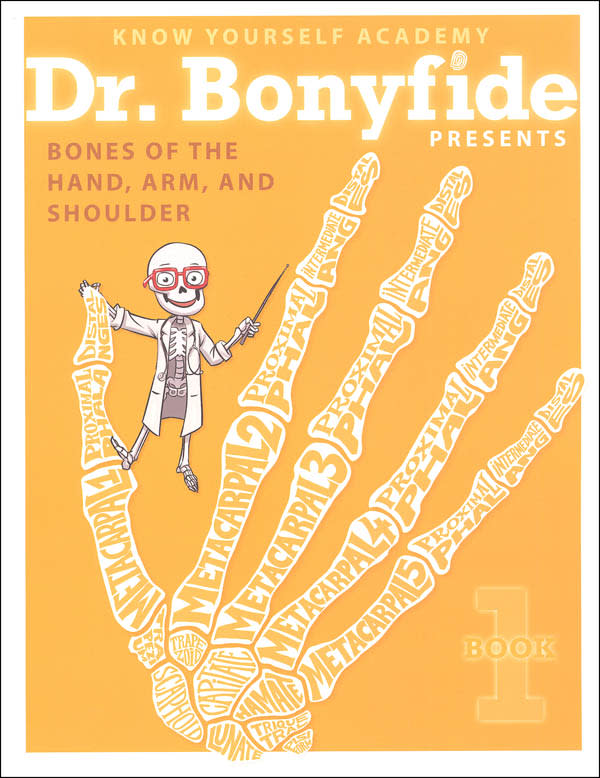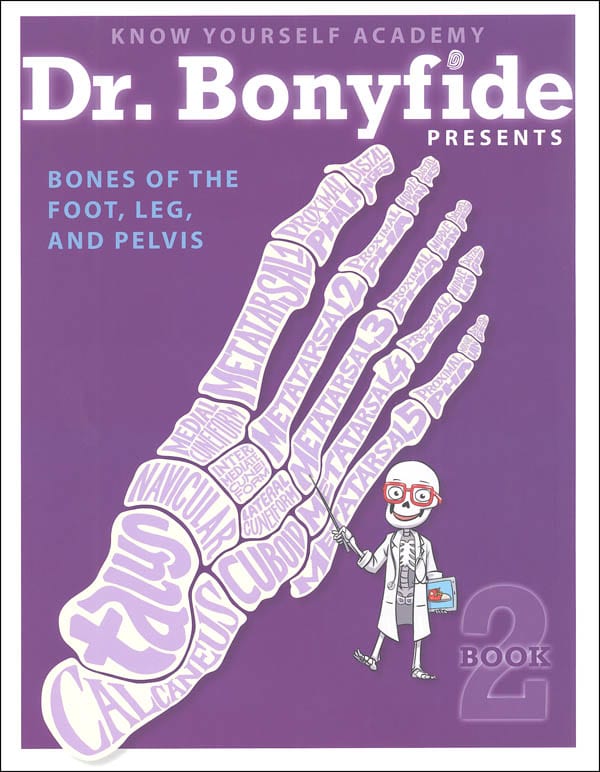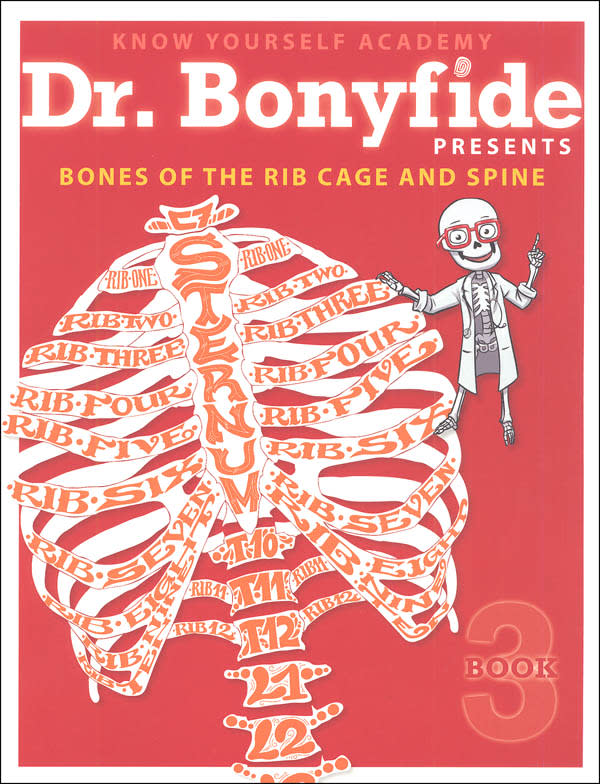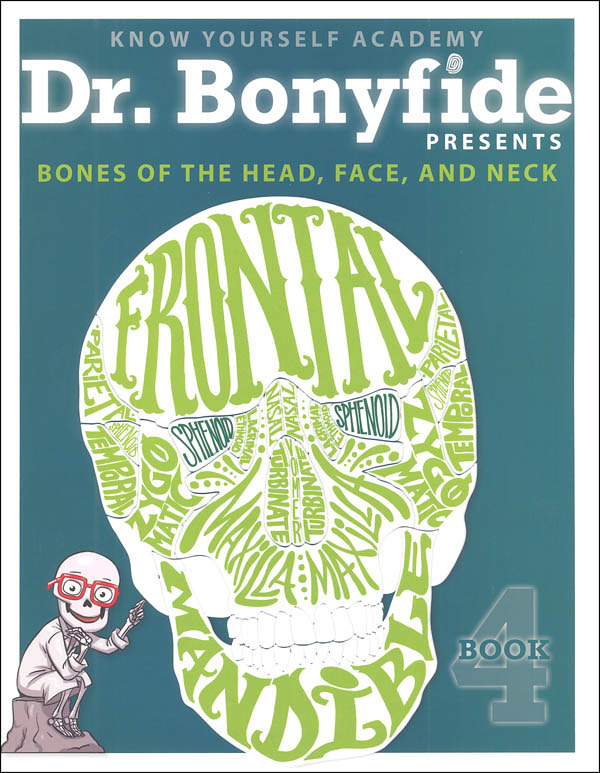Four books in the Dr. Bonyfide Presents… series teach children about all the bones in the human body in the most creative anatomy curriculum I’ve seen. The four books divide the skeletal system into four parts as follows:
- Book 1: Bones of the Hand, Arm, and Shoulder
- Book 2: Bones of the Foot, Leg, and Pelvis
- Book 3: Bones of the Rib Cage and Spine
- Book 4: Bones of the Head Face and Neck
The goal is that children will be able to identify by their proper names, every bone in the body. The books are recommended primarily for ages eight to twelve, but Book 3 and Book 4 might interest older students as well. The last two books seem slightly more difficult, probably because they go into a little more detail. Slight differences in level are also evident in things like word-search puzzles. The vocabulary is equally challenging in all books, but Book 1 has a word search that requires students to find 13 words while Book 4’s word search has 22 words.
The essential style of all four books is similar, but there are a few significant differences between the first two and last two books. All books are very attractive with full color, photos, puzzles (e.g., word search, mazes, codes), cartoon characters, songs, rhymes, physical activities, and corny jokes.
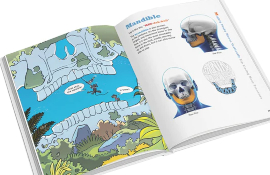 The cartoon characters Dr. Bonyfide and Pinky Le Darpals accompany students through many of the lessons. The first two books add “x-ray glasses,” attached inside the back of each book; students use the red, plastic lenses to identify hidden images in the hands, arms, feet, and legs. Cartoon drawings are featured throughout all the books, but cartoon strips (some of them multi-page) are added to Books 3 and 4.
The cartoon characters Dr. Bonyfide and Pinky Le Darpals accompany students through many of the lessons. The first two books add “x-ray glasses,” attached inside the back of each book; students use the red, plastic lenses to identify hidden images in the hands, arms, feet, and legs. Cartoon drawings are featured throughout all the books, but cartoon strips (some of them multi-page) are added to Books 3 and 4.
The books require some writing, but surprisingly, the amount of writing decreases for Books 3 and 4. Students will write on some pages throughout the books. If only one student is using the program, they can write in the book; for more than one student, you can get the downloadable set of activity pages on which students write. The first two books have students write (and review) the vocabulary terms several times in different ways, such as filling in blanks, writing to a mnemonic, and writing the words three times. In addition, they have students circle the correct option to complete sentences, do matching activities, and trace their foot or hand, drawing in the bones they have learned.
The amount of repetition and the use of the plastic lenses are probably most appropriate for students up through third and fourth grade. With older students, I might skip some of the repetition and make the lens activities optional.
Occasionally, the text is presented in rhyme such as this one on page 21 of Book 2:
They may be small, but they have might.
Those "middles" help your feet take flight!
They bend and grip; the ground gives way,
propelling you forward every day.
So keep them safe down in a shoe,
and the "middles" will take care of you.
The books are arranged to teach interrelated bones together, with detailed photos and drawings teaching the location of each bone.
Mnemonics are used throughout the books to help students recall the names of bones. One of the simplest is “DIP,” taught in Book 1 to help students remember the names of the phalanges: distal, intermediate, and proximal. They get much tougher, such as the mnemonic in Book 4, “Might Pinky Moves Vertically Zip Lining Near Treasure” to help students recall the names of the eight bones of the viscerocranium: (mighty) mandible, (pinky) palatine, (moves) maxilla, (vertically) vomer, (zip) zygomatic, (lining) lacrimal, (near) nasal, and (treasure) turbinate. Phonetic pronunciations are shown for difficult words.
Some lessons in every book teach word etymology since the meanings of the root or Latin words often connect in obvious ways that them easier to remember. For example, the word gladiolus (the middle section of the sternum) means “little sword,” and the sternum is shaped somewhat like a short sword.
The cartoon strips in Books 3 and 4 help students connect their learning in meaningful ways. For example, Pinky and Dr. Bonyfide are inside a skull in Book 4 when they encounter Lady Lacrima in a multi-page cartoon strip. The cartoon refers to the lacrimal bones, the lacrimal glands, and the production of tears, with the latter threatening to produce a flood. Our characters escape to dry ground in the ear. And Lady Lacrima’s band, also displaced by the flood, must take a gig at the Cochlear Club (in the inner ear).
The variety of activities and humorous touches make it easier and more enjoyable for students to learn what might be considered difficult information.
Every book adds an optional section of additional lessons at the end titled “Bonus Knowledge.” Bonus knowledge expands into related topics at a higher level than the rest of the content in the first two books and at the same level as the content in the last two books.
Younger students and some older students will need parents to read aloud with them because of the vocabulary terms and their pronunciations. Some parts of the books, like the cartoon strips, will work best when read independently by students who can handle the vocabulary. For most students, a combination of parental interaction and independent work should be the best approach.
Answer keys are at the back of each book.
Educator Guides
The optional Educator Guide (PDF) for each book was written for classroom groups, but homeschoolers should still find them useful for the lesson plans and pacing suggestions as well as for additional teaching ideas, games, activities, and discussion questions.
Each guide shows how to cover the corresponding book in seven or eight lessons, each lesson lasting about 45 minutes to an hour. Lesson plans provide detailed instructions for using the books along with other supportive activities. Some activities, such as team games, will work only with a group of students, but the discussion questions and many other ideas should be helpful to homeschoolers.
Some lesson plans rely almost entirely on material contained in the book, but some lesson plans add related material. For instance, the Book 3 Educator Guide adds material for the lesson on the sacrum that jumps off the idea mentioned briefly in the book--that the Latin word sacrum means sacred bone. The Educator Guide has additional handout pages to help students understand how the sacrum was sometimes treated as a sacred object and has them explore a few other sacred objects and places.
Each lesson plan concludes with a “Takeaway Challenge!”—most often a physical activity. For example, page 35 of the Book 3 Educator Guide says, “For today’s Takeaway Challenge, invent a new dance move that gets the thoracic section of your spine moving. Then give it a name!”
Other Resources
Know Yourself has many other resources on human anatomy that are worth checking out. Their Systems of the Body: Adventure Series appears to be somewhat like the Dr. Bonyfide Presents… series, especially the last two books that include cartoon strips. The Know Your Body series also covers the systems of the body, but in a format that still has lots of activities but seems a little more like a textbook.
Dr. Bonyfide’s Know Your Bones Card Deck should be great for review, and Dr. Bonyfide’s Know Your Bones Coloring Kit has pages for kids to color and cut out to construct a 40-inch skeleton, fasteners included.
Summary
The Dr. Bonyfide Presents… series teaches students about the skeletal system with an entertaining touch that should be very effective.




